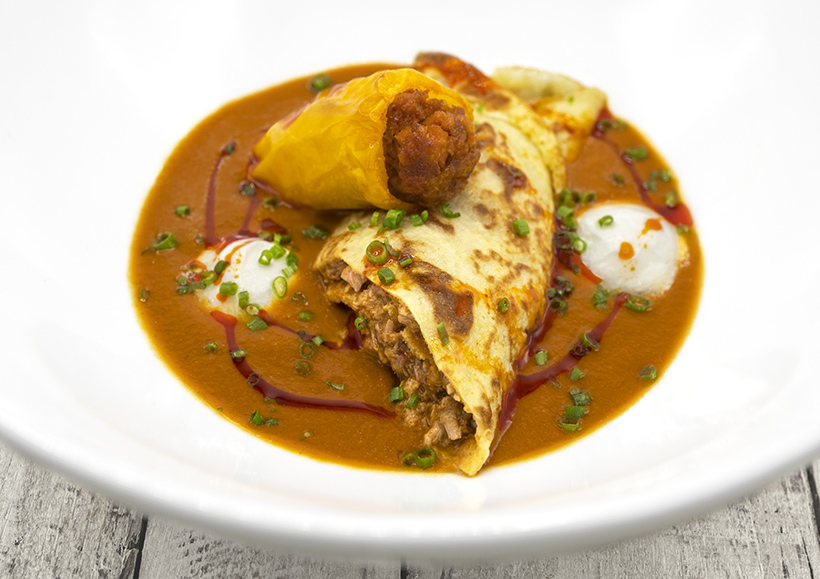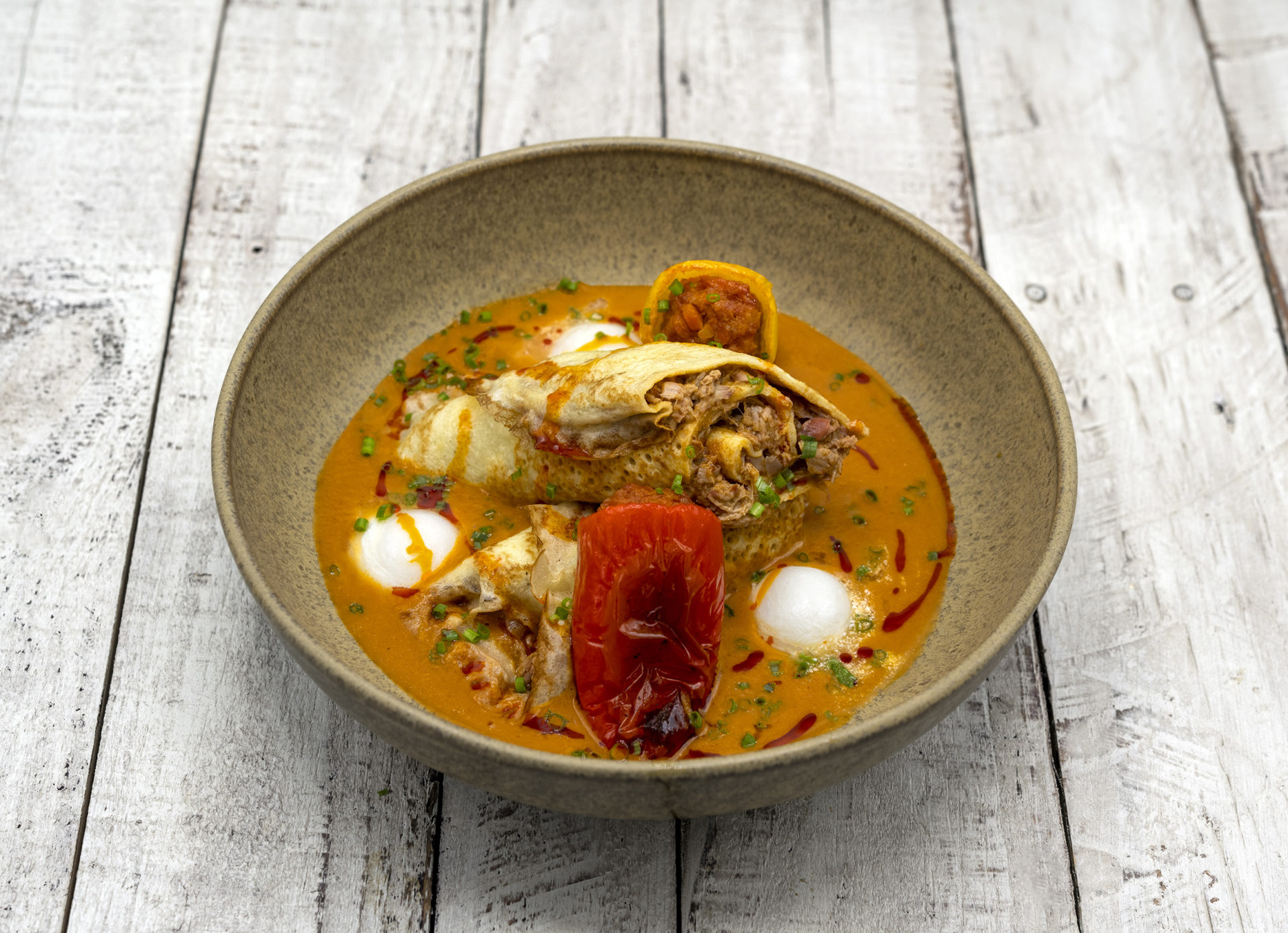Situated in eastern Hungary, the village of Hortobágy is in the center of the puszta, an exclave of the Eurasian Steppe. It’s the birthplace of the Hungarian cowboy – the csikós. Nowadays, tourists flock to the local ranches to watch spectacular horse shows, including “the most ambitious riding show on earth,” according to Lonely Planet. During their long days in the fields watching the cattle, horsemen recharge their proverbial batteries by preparing a veal paprika stew in a cauldron over an open fire. While the meat cooks, they mix some flour with the morning’s milk (adding an egg or two if they’re lucky enough to own some hens) and make pancakes on a skillet placed over a few embers. To finish, these gourmet horsemen chop the stew meat into small pieces, mix it with sour cream, fill the pancakes with this mixture, then arrange the pancakes on a dish and top with sauce. The hortobágyi palacsinta (Hortobágy pancake) is served! And to think that cowboys in the Old West lived on beans, biscuits, and dried meat, ha!
Okay… so, this story is not quite true. Hortobágyi palacsinta doesn’t originate from the Hortobágy region. In fact, it’s got nothing to do with Hortobágy, the Great Hungarian Plain, or cowboys at all! It was invented for the Brussels World’s Fair of 1958.
I’ve already talked a bit about the 1958 Brussels World’s Fair in my post about Somlói galuska. For each of the two superpowers of the Cold War, the first exhibition of its kind since World War II is seen as an opportunity to showcase their opposing ideology and way of life. On the USSR side, massive statues of Lenin or of a worker and a kolkhoz woman stand alongside replicas of Sputnik 1 and of the first nuclear icebreaker (named after Lenin, of course). On the US side, visitors attend fashion shows and concerts, discover computers and color television, and eat ice cream.

Sandwiched between the two massive pavilions, the Hungarians are nonetheless arousing a lot of interest, partly because of the revolution that took place less than two years earlier. A country where Communist rulers are still subjecting their society to counterrevolutionary red terror certainly clashes with the expo’s ideal of “a more human world,” and with its disastrous economic situation, Hungary can barely afford to have a presence in Brussels. But the new regime led by János Kádár is in search of legitimacy. Rather than making a spectacle of socialist loyalty as one might have predicted, the Hungarian authorities want to distance themselves from their pre-revolution Stalinist regime and focus instead on showing the world their small country’s cultural achievements, and feature exhibitions of everyday life that contradict the West’s impression of joyless life under socialism. Precisely because of the Hungary’s lack of funds, it has been decided that the income from the pavilion’s retail stores, restaurant, and pastry shop must more than cover, in hard currency, all the costs incurred in its construction. This gives the restaurant in particular a double mission: fly the colors of Hungarian gastronomy to prove that there’s more to it than paprika and foul gruel, and make money for the communist state.
To help ensure success as both propaganda weapon and cash cow, the helm of the kitchen is given to János Rákóczi. The famous 61-year-old chef worked in France before the war and even met Escoffier. Back home, he’s a veteran of the best hotels in the country: the Palace Hotel in Lillafüred, then the Gellért Hotel and the Bristol Hotel in Budapest. He even gave his name to a dessert (the Rákóczi cottage cheese cake) – and when it comes to desserts, Magyars do not mess around.
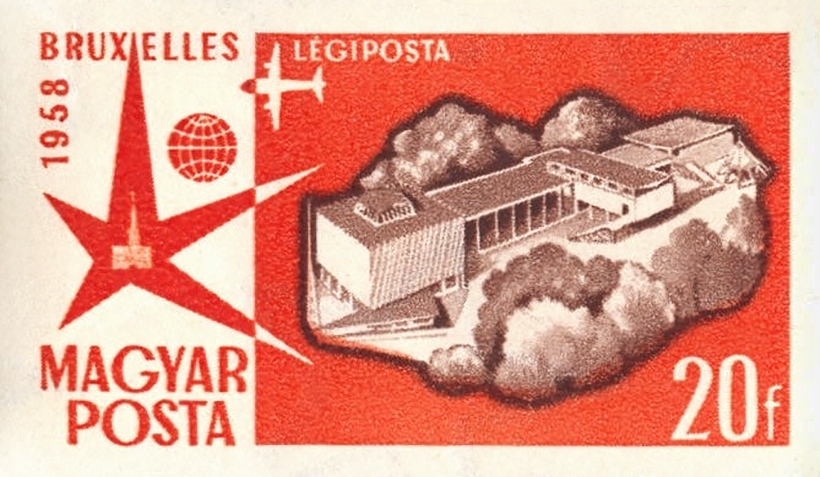
At the World’s Fair, the chef serves many Hungarian classics: chicken paprikash, zander from Lake Balaton, pork medallions with lecsó, Transylvanian mixed grill, strudel… But he also promotes recently-invented dishes like Somlói galuska and his own creations: the supercharged beef tenderloin Budapest-style (with lecsó, green peas, mushrooms, goose liver, rice and potatoes; you might remember it from my recent review of Bock Bisztró), or the famous pancakes Hortobágy-style. In a sense, this is the pinnacle of Magyar cuisine during the communist era. Rákóczi retires in 1961 and dies in 1966, which gives him just enough time to collect his recipes in a cookbook, Konyhaművészet [The Art of Cooking], published in 1964.
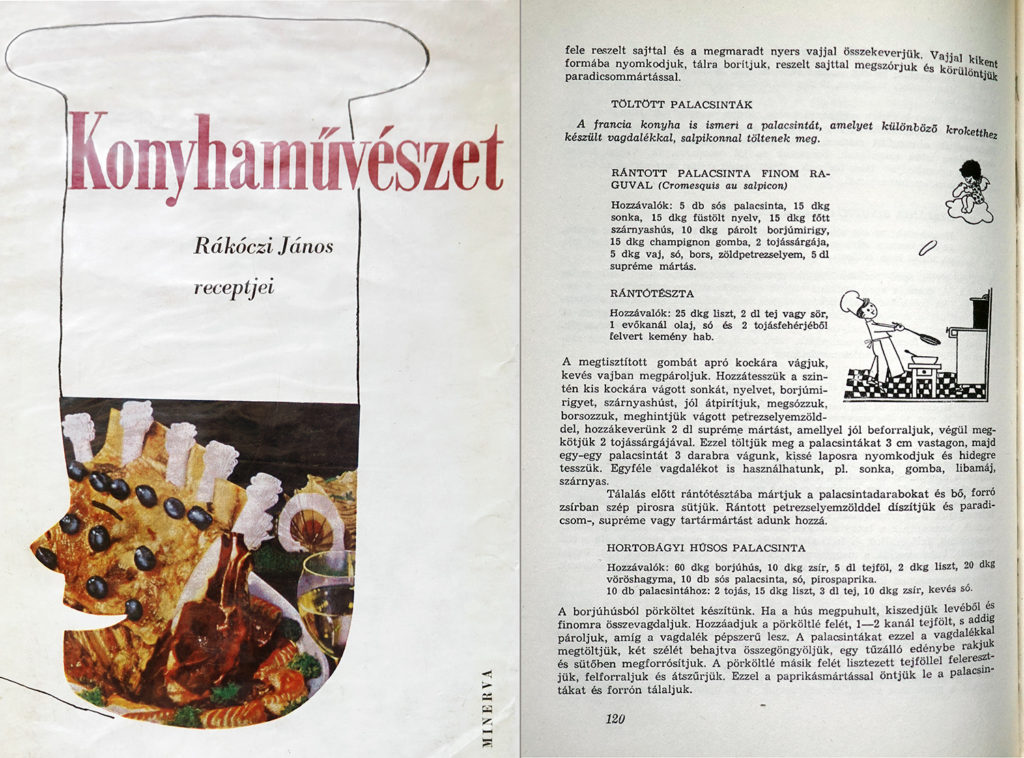
Taken from that book, here’s a translation of Rákóczi’s recipe for Hortobágyi palacsinta. Why Hortobágyi? Unknown.
Ingredients: 600 g veal, 100 g fat, 5 dl sour cream, 20 g flour, 200 g onions, 10 savory pancakes, salt, paprika
For 10 pancakes: 2 eggs, 150 g flour, 3 dl milk, 100 g fat, a little saltMake a pörkölt from the veal. When the meat has softened, take it out of its sauce and chop it finely. Add half of the sauce, 1-2 tablespoons of sour cream, and simmer until the meat has the texture of a paste. Fill the pancakes with this mixture, fold in half and roll up, then place in a fireproof dish and heat in the oven. Combine the other half of the sauce with sour cream mixed with flour, bring to a boil and filter. Pour this paprika sauce over the pancakes and serve hot.
In 1962, Hungary’s Minister of the Interior decrees that the state catering industry must use only the new Unified Catering Recipe Book to create its menus. With that, the country’s gastronomy sinks into a dark, dark age.


At least that’s how the story goes. But was hortobágyi palacsinta really invented for the 1958 World’s Fair? Rákóczi didn’t pull the idea for the dish out of thin air – far from it. The 1939 book A gyakorlati főzés tankönyve száz ebéd keretében [Textbook on Practical Cooking through a Hundred Lunches] by Andrea Kollmanné Lemhényi Dávid, already contains a recipe for a kind of Hungarian lasagna featuring the same ingredients:
Make a veal pörkölt and bake pancakes. Finely chop the prepared stew with a large knife and place in an ovenproof bowl, layered with the baked pancakes. Pour the pörkölt sauce mixed with sour cream on top. Bake on the middle rack of a oven preheated on low for 15 minutes.
(It should be noted that a palacsinta, though translated as pancake in most cookbooks and in this post, is really supposed to be wide and thin, like French crêpes or genuine Russian blini.)
Even before that, Elek Magyar’s 1932 volume Az ínyesmester szakácskönyvek [The Gourmet’s Cookbook], considered the bible of Hungarian cuisine – anything that’s not in it simply does not exist in classical Hungarian gastronomy – includes, somewhere in the middle of its approximately 2000 entries, a recipe for meat pancakes:
Make a regular pörkölt from veal or lean pork. When done, take the meat out of the sauce, mince with a little sour cream and mix with an appropriate amount of sauce. Make pancakes without sugar, fill with this mixture and roll. Bake in fireproof dish in the oven for 10 to 12 minutes.
And there’s more before that! In 1909, A Divat Ujság Főzőkönyve: Legtartalmasabb magyar főzőkönyv [Cookbook of the Fashion Newspaper: The Most Comprehensive Hungarian Cookbook], which clocks at a whopping 2300 recipes, includes pancakes filled with chicken paprikás:
For the filling, cut into pieces a small but meaty chicken (one chicken is enough for six people). Simmer with finely chopped onion and good Szeged paprika until tender, then take out the meat and mix sour cream into the sauce. Take the chicken off the bone, chop very finely, put back into the sour cream and paprika sauce, and simmer a little. Bake the pancakes as thin and crispy as possible, stuff them with meat filling and roll them up. Place in a good strong porcelain plate, cover with a little salted sour cream, then bake until the top is crispy and the whole dish is hot, and serve to the table.
And really, in a country known for its pancakes (not to mention its strudels) and its paprika stews, chances are that the idea to combine the two arose even earlier than that – perhaps in the 19th century, a few decades after paprika became a staple of Hungarian cuisine (see my short history of the beloved red pepper powder here). After all, it could very well be that somewhere on the Great Hungarian Plain, people were indeed eating pancakes filled with veal pörkölt and sour cream!

My recipe is inspired by the Hortobágyi palacsinta I ate at Bock Bisztró in Budapest, especially in terms of presentation: the fat pancake cut in half, the vibrant colors, the drizzle of red pepper oil, the sour cream pearls. The methods of preparation are distinctly mine, though. The veal, from the shank, is cooked sous vide. The red oil is made with smoked paprika. For the sour cream, I opted for salty half-spheres made using a technique called reverse spherification (you can buy the necessary ingredients and tools here). I even take the same ingredients but combine them differently to make stuffed mini peppers. Maybe this updated version can be served at the Hungarian pavilion of the next World Expo…
Hortobágyi palacsinta
Yields 4 servings as a main course (or 8 servings as an appetizer if you make 1/3 more sour cream spheres)
Total preparation: 75 hours
Active preparation: 2 hours
Paprika sauce
225 g peeled onion
45 g olive oil
salt
1 g ground star anise
4.5 g sweet paprika
15 g tomato paste
350 g cored and seeded red bell peppers, sliced
100 g peeled and seeded tomato, large dice
200 g veal stock
120 g sour cream
5-10 g sugar (optional, see below)
- Slice the onion very thinly with a mandoline. In a pot over medium heat, sauté the onion in 1/3 of the olive oil, season with salt, and cook until soft but not colored.
- Add the star anise and cook for 1 minute, stirring constantly, then add the paprika and tomato paste, and cook for another 2-3 minutes, stirring regularly.
- Add the red pepper and tomato with the rest of the olive oil. Season with salt, and cook until just soft.
- Add the veal stock, simmer for a couple minutes, then remove from the heat and let cool for 5 minutes.
- Transfer to a blender with the sour cream, and process until smooth. Taste the sauce and rectify the seasoning; add a little bit of sugar if it’s too acidic. Pass through a chinois and let cool. Refrigerate until needed.
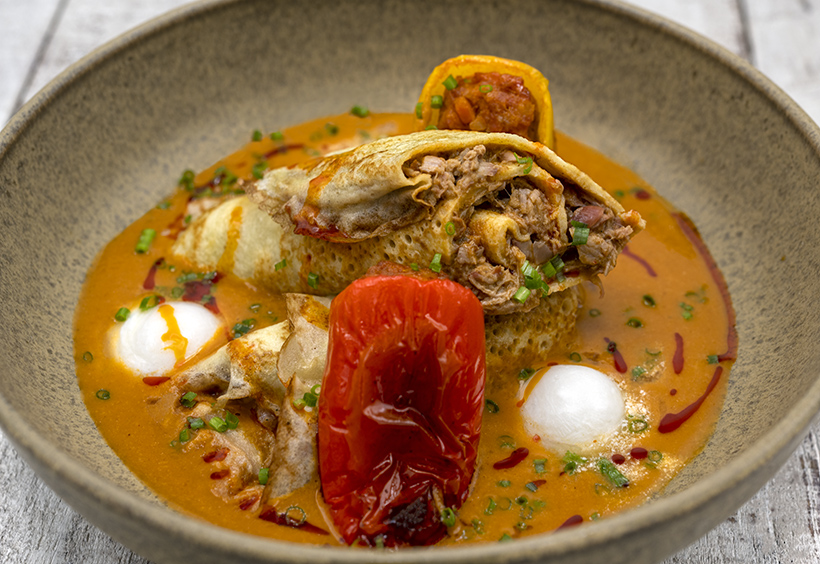
Veal shanks sous-vide
900 g veal shanks (osso buco cut)
5.5 g salt
15 g canola oil
4 g sweet paprika
200 g paprika sauce
- Season the veal shanks with salt on all sides. Heat the canola oil in a pan over high heat, then sauté the meat until brown on all sides.
- Transfer the veal shanks to a cutting board. Season with paprika, then transfer to sous-vide pouches (placing one or two pieces in each pouch), add the sauce, and vacuum-seal. Cook in a 68 C / 155 F water bath for 72 hours. Let the pouches cool for 30 minutes.
- Take the veal out of the braising liquid. Remove and discard the bones, excess fat, and silverskin. (Optionally, you can take the marrow out of the bones and add it to the meat). Cut the meat into small dice, then transfer to a bowl and add the liquid from the pouches. Cover and refrigerate until needed. The veal shanks can be prepared a day ahead.
Smoked paprika oil
50 g olive oil
5 g smoked paprika
5 g sweet paprika
- Heat the olive oil in a very small saucepan over low heat until it reaches 93 C / 200 F. Remove the pan from the heat and stir in the smoked and sweet paprika. Let steep for 1 hour.
- Transfer the oil to a blender and process for 30 seconds on medium speed. Pass through a chinois, then through a 100-micron filter, and transfer to a small squeeze bottle. The oil can be kept in the refrigerator for up to a week.

Stuffed mini peppers
30 g peeled onion, small dice
30 g peeled carrot, small dice
10 g olive oil
30 g peeled and seeded tomato, small dice
100 g ground veal
12 g sour cream
12 g panko breadcrumbs
2.5 g sweet paprika
2.5 g salt
8 cored and seeded mini peppers (about 200 g)
- In a small saucepan over medium heat, sauté the onion and carrot in the olive oil until soft. Remove from the heat, add the tomato, and let cool.
- In a bowl, combine the ground veal, sour cream, vegetable mixture, breadcrumbs, paprika, and salt, mixing with a fork. Fill the mini peppers with this forcemeat, then individually wrap each one in plastic film, and refrigerate.
Sour cream spheres
1000 g filtered water
5 g sodium alginate
100 g sour cream
1 g salt
1 g calcium lactate
- Pour the water into a bowl. While blending with an immersion blender to create a vortex, sprinkle the sodium alginate on top of the water; continue to mix until the powder is dissolved and the liquid thickens to the consistency of a fluid gel. Refrigerate for at least 2 hours, so that all the air bubbles come out of the mixture. This will be your setting bath.
- In a small bowl, whisk the sour cream with the salt and calcium lactate for one minute, until dissolved. Pour the mixture into a silicon mold of 3 cm diameter half-spheres, using an offset spatula to level – you should obtain 12 half-spheres. Cover with plastic wrap and freeze for at least 2 hours, until the spheres are solid.
- The spheres will be completed just before serving.
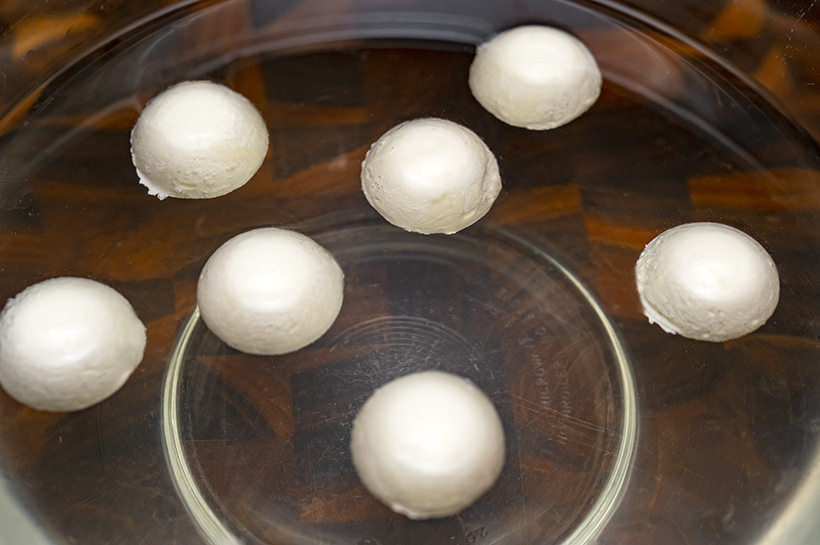
Pancakes
65 g AP flour
2 g sugar
1 g salt
50 g (about 1) egg, beaten
80 g milk
15 g butter, melted
80 g carbonated water
- Combine the flour, sugar, and salt in the bowl of a mixer fitted with the whisk attachment. Add the egg, milk, and half of the butter progressively while beating on medium speed. Let rest for 30 minutes.
- Heat one or more 24 cm diameter skillets over medium-low heat. Add the carbonated water to the batter and mix until homogeneous. Grease the pan(s) with a little bit of the remaining butter for each pancake. Using 70-75 g of batter each time, you should obtain four pancakes, thin but not paper-thin. Cook until brown on both sides, flipping as needed, then reserve on a plate and cover with plastic wrap.
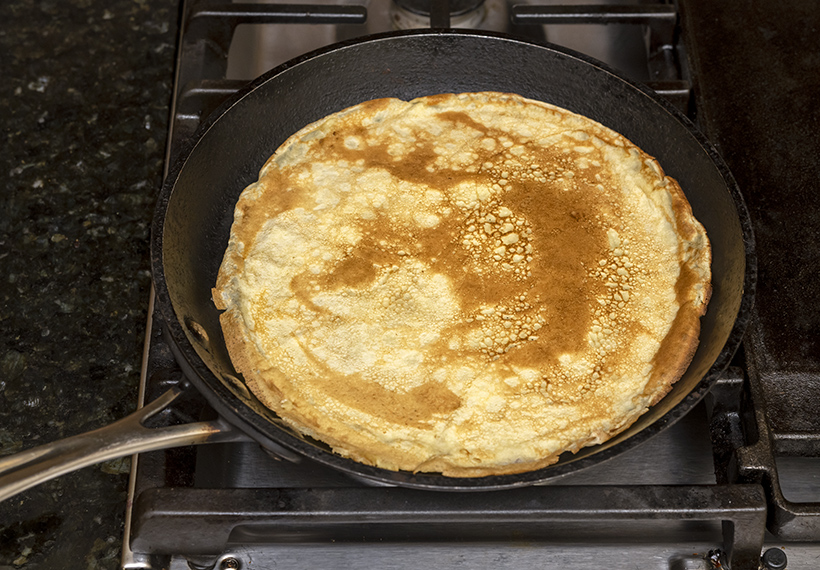
Assembly
stuffed mini peppers
15 g olive oil
sour cream spheres (frozen spheres and setting bath)
paprika sauce
veal shanks sous-vide
0.4 g lemon zest, grated using a Microplane
pancakes
smoked paprika oil
about 4 g chives, finely sliced
- Place the stuffed mini peppers in an oven dish and drizzle with the olive oil. Cook in a 200 C / 400 F oven for about 30 minutes, flipping after 15 minutes. Reserve.
- Drop the frozen sour cream spheres into the setting bath for about 3-4 minutes, until a skin has formed. Leave space between them so they don’t stick together. The longer they remain in the bath, the thicker the skin. Prepare a bowl of cold water. Take each sphere out of the setting bath, dip in water to rinse, and reserve on a plate. Refrigerate for 15 minutes (the cream will still be frozen).
- Reheat the paprika sauce in a saucepan over medium heat and reduce by about 1/4.
- Reheat the veal shank meat with the lemon zest in a saucepan over low heat.
- Drain the meat through a sieve, and mix the strained liquid into the sauce.
- Reheat the pancakes in the microwave. Place one pancake on a board, cover with about 150 g of veal mixture and about 15 g of sauce. Roll tightly, then cut in half on a bias.
- In the center of each bowl, pour a puddle of sauce and arrange two pancake halves, one on top of the other, with two stuffed mini peppers resting against them. Gently transfer three cream spheres around the pancakes and mini peppers. Drizzle all over with smoked paprika oil, and sprinkle with chives.
- For a half-serving, use one pancake half, one stuffed pepper, and two cream spheres.
